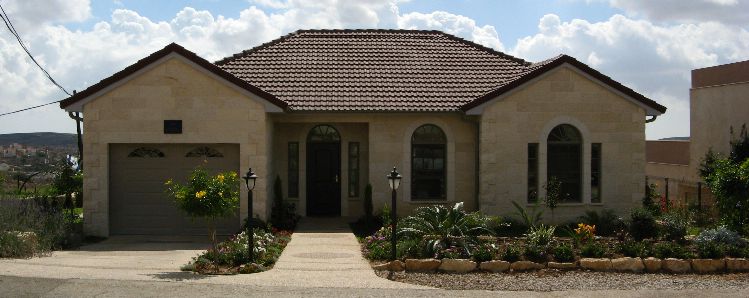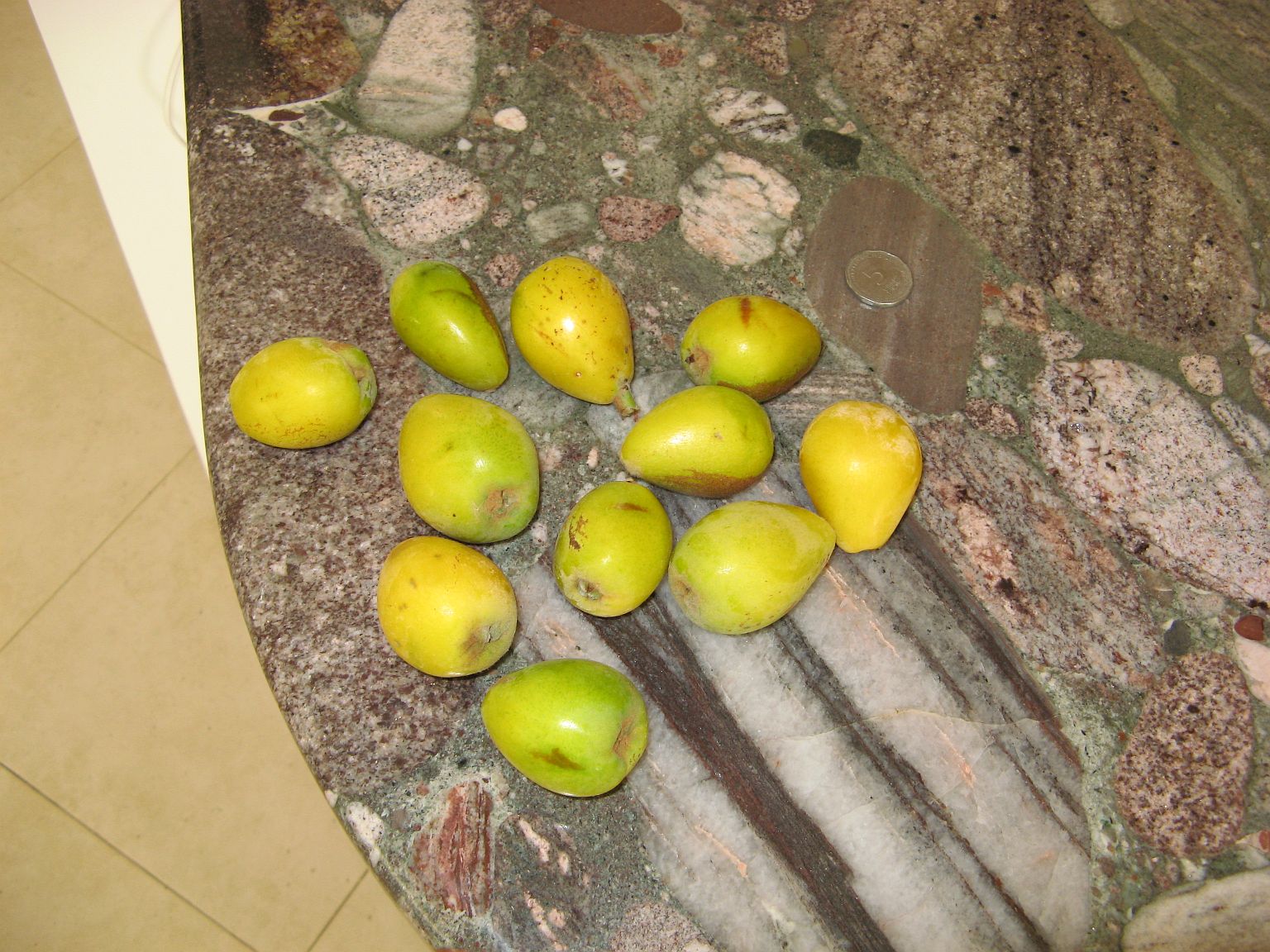

This article describes my experience taking care of my garden in Shilo, which is in the Shomron area of Israel. The Shomron is the mountainous area that extends from its southern border just north of Jerusalem until the Jezreel Valley in the north. It is bounded by the Jordan Valley on the east and the Mediterranean coastal plain on the west. The highest peak in the Shomron, Mount Hazor (approximately 1014 m above sea level), is south of my garden, about 15 minutes away by car. My garden's elevation is almost exactly 800 meters above sea level.
To understand my approach to gardening in the Shomron, there are a few other things you need to know about the Shomron, and also some specific things about my garden.
The yearly rainfall in Shilo between 2003 - 2012 was between 240 mm and 740 mm, with an average of 480 mm, nearly all of which fell between October and April, with May through September, a span of five months, having virtually zero precipitation. It is clear then, that during the summer months, especially as the garden is being established, it is advantageous to irrigate the Shomron garden. With the era of inexpensive water in Israel having drawn to a close, each gardener will have to decide for their self how much money they are willing to invest in their gardening.
Most sources recommend watering either in the early morning or evening and not during the peak sunlight hours and this is what I have followed; I generally water between the hours of 3 AM and 7 AM. The reasons suggested for not watering during peak sunlight hours is that the water will evaporate rather than sink into the earth, and droplets of water can act as lenses to focus the sun's rays, thereby causing burn damage. Based upon my experience to date, I feel that the major cause of problems in the Shomron garden are due to failure to water enough. Looking at this differently, you could say that they major source of problems is trying to establish plants that do not belong in this area due to their needs. Another problem, often seen in starting new plants, is failure to plant the root ball at the recommended level with regard to the surface. I think this problem, too, is a water problem, because the level of the root system affects the ability of the plant to imbibe water.
Clearly, unless you are independently wealthy, you will want to put plants in the Shomron garden that do not require a lot of water. Additionally, there are many plants that will tolerate less water once their root system becomes established.
A mistake I made many times during the first few years of my gardening experience was underestimating how long it takes for the root system of a new plant to become established. I now think it takes nearly a year. Unlike in regions of the United States where winters are severe and many plants are truly dormant, in the Shomron, where the temperature rarely goes below 0°C, plants are not dormant in the winter, but are busy developing their root system. This means that during a new plant's first winter it is a good idea to give it supplemental water any time more than two weeks pass without rain. It goes without saying that in the summer months, when plants are busy blooming and growing, and it never rains, it is essential to water, especially during that critical first year.
Modern Shilo is situated on a mountain and the most accurate thing you can say about its topsoil is that there isn't any. The topsoil for my garden was carted in by truck from the Petach Tikva area. It was very clay-like. For my 325 m2 garden, I brought in 100 m3 topsoil and mixed it with 6 m3 of compost. I may have been overly generous with the depth of topsoil (30 cm), as well as with the amount of added compost (6%), but more is better than not enough. The compost makes the soil less dense and better able to absorb required nutrients. In fact, in this area of Israel, it is a good idea to add and mix in additional compost yearly. Sometime around the month of November is suitable for this, as well as for adding slow-release fertilizer.
The notion that there are just two seasons in Israel
[ref
1] is, IMHO, a common misperception, or at the very least, an
over-simplification. I believe that if you are perceptive enough, you will see
the traditional four seasons.
The chart below shows what happens in my Shomron garden during the four
seasons.
| Spring happenings | |
|---|---|
| Late January | almond trees and irises bloom, lavender shows good color, buddleia starts growth, tiny bumps start forming on pomegranate and yellow elder bushes, etc |
| Early February | small loquat fruit, first noticeable in January, continue to grow and attain significant size |
| Late February | watsonia bloom, bougainvillea, lemon tree and pomegranates start leaves |
| Early March | daffodils, mustard bloom |
| Late March | canna start to grow, make leaves |
| Early April | start of thunburgia growth, hibiscus leaves, collistemon, lemon tree, and bauhinia blossom |
| Late April | bougainvillea, pomegranates, and honeysuckle bloom |
| Early May | day lilies, amaryllis, buddleia, and baptisia tinctoria bloom,
new growth on allamanda, apply 6-month fertilizer |
| Summer happenings | |
| Late May | end of collistemon bloom; canna start to bloom (will continue until winter) |
| Early June | hibiscus syriacus flowers bloom |
| Late June | blue thunbergia, crepe myrtle bloom |
| Early July | quiet |
| Late July | quiet |
| Early August | quiet |
| Late August | end of buddleia bloom, start of pampas and other grasses making pods |
| Early September | quiet |
| Fall happenings | |
| Late September | Leaves on crepe myrtle and allamanda turn yellow, time to trim hibiscus |
| Early October | quiet |
| Late October | Apply compost, 6-month fertilizer |
| Early November | Apply compost, 6-month fertilizer |
| Late November | rakefet blooms |
| Winter happenings | |
| Early December | pomegranates lose leaves |
| Late December | bougainvillea lose leaves |
| Early January | hibiscus lose leaves |
The above times for blooming, etc., are for a well-fertilized, well-watered garden. Gardens left to fend for themselves undoubtedly will show a different schedule.
With the help of Batsheva Kantor, former curator of the Jerusalem Botanical Gardens, I tried to select plants such that something of interest happens at all times of the year.
I found it interesting that in my Shomron garden, irises blooming is
among the first signs of Spring. In my garden in Silver Spring, Maryland,
United States, the first signs of Spring were crocuses blooming, followed by
forsythia, and then azaleas; the irises generally bloomed well after the
azaleas, much later in the calendar year than here in Israel.

After planting a fruit tree in Eretz Israel, Jewish law prohibits deriving benefit from the fruit during the first three years. Fruit of the first three years is called orlah. In general, fruit trees do not bear fruit during these years. However, I planted established trees that were already bearing fruit. In order to avoid any problems with orlah and not waste the fruit tree's energy making fruit I would not eat, I picked off all the blossoms for the first three years.
Although a literal translation of the Torah suggests you must wait four years before enjoying fruit from trees planted in Eretz Israel, the Rabbis teach us that we may use the fruit after three years so long as we first peform the mitzvah of neta revai. The picture above shows loquats and a coin set aside prior to performance of that mitzvah.
After four years, it is necessary that the mitzah of giving
terumot and maasrot be
observed before eating fruit grown by a Jew in Eretz
Israel.
Loquat trees seem to do well in Shilo and require very little attention, with one exception. Ripe loquats are a delicacy for birds. I tried protecting the fruit with nylon netting, but the kind I used had too course a mesh and rather than protecting the fruit from the birds, it ending up trapping them. After spending over an hour freeing a bird from the netting, I removed the netting and learned to pick the fruit as soon as it was ripe (yellow). If I picked too early, the fruit was less tangy and tasty; if I picked too late, the birds got the lion's share of the yield. If I was right on target, the fruit was delicious.
Because of strong spring winds, lemon trees reportedly don't do well where my tree is located. During the third year, all the blossoms on my lemon tree died without producing fruit. But during the fourth year, about a dozen fruit are growing. The first fruit picked, somewhat prematurely, was a little too bitter, but I hope, like the loquats, if picked at the right time, they will be tasty. The leaves of my lemon tree have a tendency to turn yellow and fall off. This was somewhat mitigated against by applying fertilizer for acid-loving plants, as described below.
None of the pomegranate blossoms during the fourth year proceeded to fruit. The following year, I had a yield of about six good-sized pomegranates.
I generally fertilize all my plants and trees in early May with 6-month time-release fertilizer. Early November is reserved for fertilizing again, weeding, trimming, and pruning, and mixing additional compost into the soil. Each tree is centered within a circle of aproximately 70 cm kept clear of weeds or grass and receives 5 - 10 liters of added compost. Large bushes are treated similarly, with smaller plants receiving less fresh compost. A few acid-loving plants and shrubs, specifically my camellia, allamanda, rose bush, and lemon tree, are singled out for bi-weekly treatment with something purportedly specifically designed for them and called an organic mineral fertilizer containing NPK 7-5-7 plus microelements. It is applied as a 5% v/v water solution.